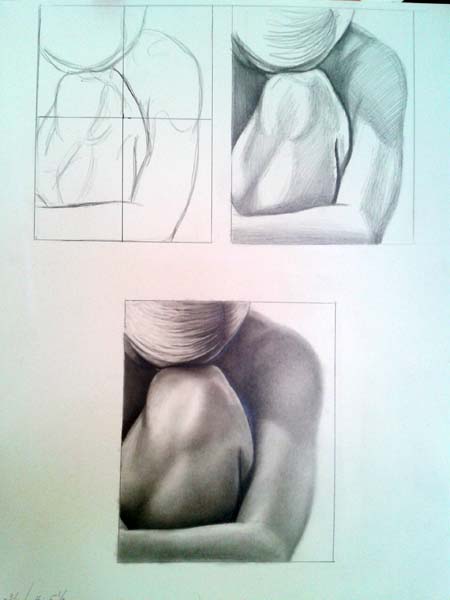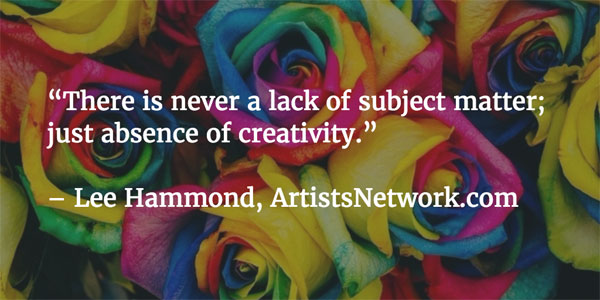Art Therapy | How to Overcome Artist’s Block

Any creative person has a time when the ideas seem to run dry, and art inspiration becomes sorely lacking. It’s a common dilemma that links all of the creative fields together, and plagues every artist. Whether it’s a songwriter/ musician whose tunes won’t seem to come, or an author such as myself where I suddenly have no words; a dry spell is a miserable inevitability. While I have yet to find an answer to writer’s block, I’ve found that my artwork is a different matter. As an artist, I’ve come up with a solution to overcome my artist’s block, and it never seems to fail me.
I coined this phrase many years ago: “There is never a lack of subject matter; just absence of creativity.” (I was really proud of myself for coming up with it!) I liked that quote so much that I had a banner of it created, which ran around the wall in my studio. It’s reminder to all of us that life provides everything we need to be creative at all times. It’s up to us to find it, and decide what we do with it.

Sometimes finding inspiration is hard. I know hard. I was diagnosed with MS almost 19 years ago. At that particular time, I felt as if life as I knew it was about to be over. I was right. But it changed my life in a way that even surprised me. It has made me a better person, and a better artist. It helped me find my voice and become a writer. I’m much stronger now than I would’ve been without the diagnosis, and I’ve learned to appreciate each and every day in a way I know I wouldn’t have, if I hadn’t become sick. We become the sum total of how we deal with the things life hands us. I chose to make it a positive.
It isn’t without its challenges, however. While I’m currently doing great, there are times when I feel so worn out and fatigued that my creativity suffers. I no longer feel the burning desire to draw or paint, and writing is nearly impossible. It’s as if my brain has a veil over it, and I simply can’t think clearly. Teaching becomes a challenge. I try to be upbeat, even when I’m sound-sensitive and everyday chatter amongst my students seems to be coming out of a megaphone, overwhelming my senses. I’m pleased to say I’ve never cancelled a class because of it, even when I honestly wanted to. I’ve never missed a deadline either. I keep on trying. But, just an ordinary day becomes simply exhausting. And creativity, well, that becomes an emotion that is eclipsed by fatigue and pain.
But, being the driven person that I am, I’ve developed a method to offset those dark hours. Rather than wallowing in despair, making excuses to my publisher, and lamenting my condition, I use it to my own advantage. I used to fight it, and force myself to keep on as if there was nothing wrong. While that can work for a while, it’s only a flimsy facade that cannot be maintained without it entirely collapsing. So, instead, I’ve learned to embrace these times as periods of healing and being cozy. I’ve also learned to use these episodes as an opportunity for developing new, creative ideas. These down times prepare me for when I feel great again, and can return to the over-achiever that I know I am.
Ways to Overcome Artist’s Block
Here’s what I do. I create a cozy place for myself. This place is what my kids have come to call my “fat chair.” It’s my favorite chair, in the corner of the living room where I have all of my creature comforts within arms length. That includes drawers with my art supplies such as colored pencils, mechanical pencils, tortillions, lead, and erasers. It also includes my favorite pencil sharpener, knitting needles, crochet hooks, magazines, books, and the TV remote. But, along with all of these items, it contains what’s essential in these dreary down times. There, I also have my view finders.

If you’re a fan of my books, you’ll find references to these amazing little tools. You can find an example of viewfinders on pages 29-31 of my book titled Lifelike Drawing. This is a method I created to help teach my students, which I use in many of my books. My book Draw Animals in Nature is filled with what I call “segment drawing,” all done with the aid of a viewfinder.
Viewfinders are nothing more than small openings cut into pieces of paper, to create mini frames. By placing these frames over photographs, you create small compositions to draw from. This isolates specific areas in the photos, to give you practice with problem areas, without having to create an entire piece of artwork.
When I’m feeling less than stellar, I gather up the photo references that I collect by the hundreds. These include photos that I take myself, as well as pictures out of magazines. I cozy up with a cup of tea or coffee, a nice blanket, a good chic flick, and yes…chocolate! Then, I slowly go through my photo references, one at a time. I use the viewfinders to isolate areas within the photos, to create mini-compositions. For instance, I’ll choose some of the flower photos I’ve taken, and place the viewfinder over them to see if cropping a portion of the photo will look more interesting. Usually the opening in the viewfinder is only a 2-inch square, so it’s easy to create a whole new look by isolating just a portion of the photo. Sometimes I can find two or three great ideas within one picture! These new compositions are inspiring. Sometimes they’re good for practice, and for placing in a segment drawing notebook. (This is also explained in my books.) But sometimes, the composition looks so cool that I’ll decide to blow it up and turn it into a large, finished piece of art. I continue going through the photos, taping down the viewfinders when I score a good one. It’s exciting to see a composition jump out at me, as if to say, “Draw me!”

I then place these photos into a separate file that I call “next.” These become the pieces I want to do someday, when I’m back to being my old, creative self again. It gives me something to look forward to, which for a creative person, is very, very important. Even though I’m not drawing per se, this process keeps me feeling creative. It also keeps me from falling down the rabbit hole of despair when times are hard, and I feel like crap. (I’ll just say it how it is!)
Feel free to use this form of “art therapy” if you find yourself in a similar a creative slump of artist’s block. We all go through it. Maybe you can find the same solace in it as I do. I’ve found it to be my safe place. Always remember, no matter what….
There is never a lack of subject matter; just absence of creativity.
– Lee
• Lee Hammond has been called the Queen of Drawing. That may not be fair these days, since in addition to providing the best drawing lessons, she has also created fantastic books and videos filled with the same easy to follow acrylic painting techniques, colored pencil techniques and more. Click here to see all of the instructional books and DVDs that Lee Hammond has to offer!
• Free download! Easy Acrylic Painting Techniques by Lee Hammond






My quote, “There is never a lack of subject matter, only a lack of will!”
When your subject matter is realism I can’t understand artist block. I think you may Be getting artist block confused with lack of motivation. Not much creativity is needed when drawing realism, rather sheer drawing skill and technical skill.
Wow! Thankyou Lee….. I used this idea today, great fun and
Really helped as I was feeling a bit down about my lack of Artistic inspiration…. I shall continue with my viewfinder until I am back to my normal self. I am going to purchase one of your books, Draw animals in nature.. Thanks again for sharing this idea with us.